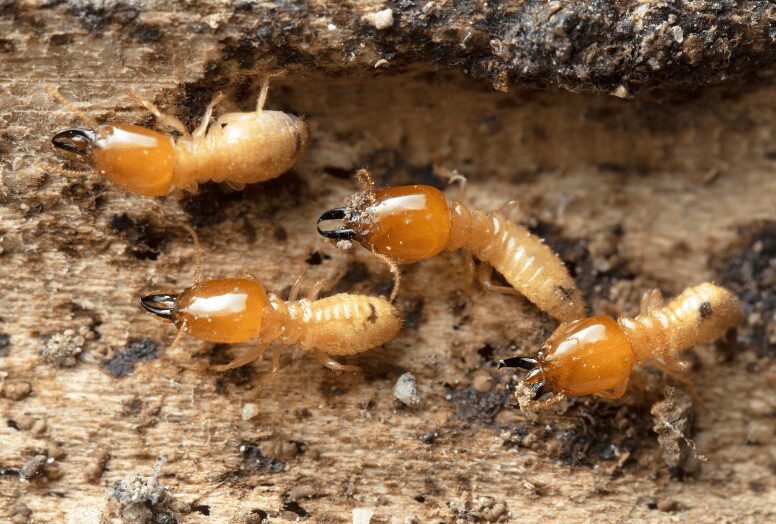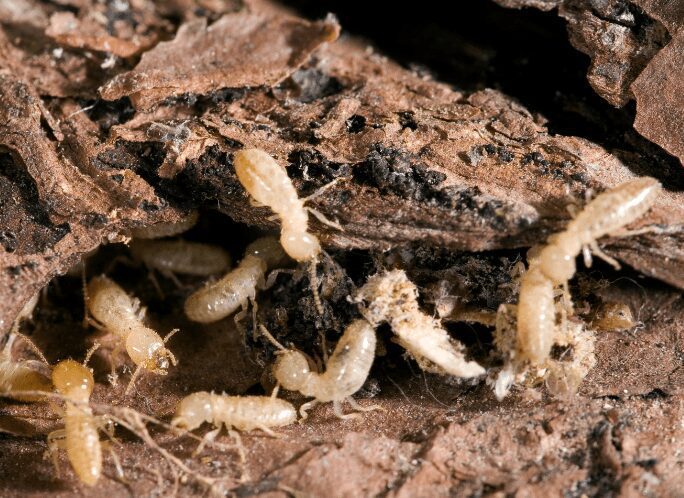What Are Termites?

- An insect that eats wood or anything containing cellulose is called a termite.
- Inspect your home for signs of termite infestation, such as mud tubes and wood damage.
- While this article may help you identify signs of termites, you’ll need a professional to eliminate an infestation permanently.
Recently, you noticed some insects fluttering around your home and are worried about termites.
But how can you tell they’re termites?
If you find termites in your household, what should you do?
Like ants, termites are small wood-destroying insects that live in colonies. The US Environmental Protection Agency (EPA) estimates they cause billions of dollars in structural damage annually.
Besides wood, they can damage anything containing cellulose, including wallpaper and carpets. They won’t eat plastic and foam but enjoy tunneling through them.
If you know how to notice them, you can prevent and promptly treat infestations before they become expensive.
The Pest Control expert shares five common signs of termites you should never ignore.
It is common to confuse carpenter ants with termites. Approximately 1/2 to 5/8 inches long, they have translucent wings, narrow bodies, and are black with red hues.
Contact a professional exterminator if you are uncertain about the type of pest you are dealing with, such as termites or carpenter ants.
Sign 1: Swarmers (flying termites)
Swarmers are flying termites that don’t bite, sting or eat wood. However, they are often the first signs of termite infestations.
In the swarming season, they are only interested in reproducing and establishing new colonies. In the spring, you’re most likely to see flying termites and find wings.
If you spot discarded wings in your home, that can signify that they have infested it.
The wings of termite swarmers are pale in color and are usually between ¼ to ½ inches long. As swarmers find mates, they shed their wings, often leaving them on windowsills and other entry points.
Sign 2: Hollow or blistering wood
Another sign of termite activity is damaged wood. The most common places to see wood damage are door frames, deck posts, porch steps, and structural supports where termites can enter your home through wood-to-ground contact.
A careful inspection of the damaged area for mold or mildew is recommended if you notice wood damage.
The appearance of mildew is typically powdery, while the appearance of mold is typically wet or fuzzy.
The presence of wood rot isn’t a sign of termite damage, but continuously damp wood can attract pests such as termites.
Wood that breaks apart easily characterizes dry rot, which occurs when fungal spores come into contact with damp wood.
In contrast, hollow wood or wood with tunnels is a sign of termite infestation. When wood is hollowed out, it sounds hollow when you tap it.
Sign 3: Frass
The presence of termite frass, or feces, is another indication of termite activity. Termites are burrowing through and eating the wood in your home when they leave a pile of frass behind.
When termites eliminate droppings from their nests, they leave behind small tunnels throughout your home. The areas where you’ve found frass may sometimes have holes.
Depending on the species, droppings are generally tiny and wood-colored. It is possible to mistake them for sawdust or dirt.
The expert explains that frass can give off a moldy or mildew odor even if you cannot see it.
Sign 4: Mud tubes
Eastern subterranean termites are the most likely to cause damage to homes in the US, according to the University of Missouri Extension Service.
Most likely, subterranean termites will create mud tubes, brown-colored tunnels formed from wood and soil, measuring about 0.5 to 2.5 centimeters in diameter.
Due to their soft bodies, these termites can travel around your home without being exposed to external threats like dry weather or predators.
It is possible, however, for subterranean termites to gain access to your home through other means.
It doesn’t mean you don’t have an infestation just because you don’t see mud tunnels outside your home.
Mud tunnels can still identify termites. Termites often build mud tubes along fences, porches, tree trunks, and corner walls.
Two types of termites can damage wood: Carpenter ants and termites. Termite tunnels and mud tubes, or galleries, are raggedy in appearance rather than smooth and polished, as are those of carpenter ants.
Sign 5: Tight-fitting doors and windows
It may also signify termites if doors suddenly become difficult to close or open.
Door and window frames can expand due to termite activity, making these entryways more challenging to open and close.
It is most likely to occur with subterranean termites, which emit a more significant amount of moisture than other species.
Frass and wood damage may indicate termite activity around your doors or windows.
Termites are most likely to damage Dampwood, Drywood, and subterranean structures in the US. According to experts, knowing the type of termite you’re dealing with is essential. “If you exterminate against the wrong type, chances are it won’t work, and they’ll continue”
What to do if you identify one of these signs
To treat a termite infestation properly, you should call a professional to inspect the damage and decide the best course of action.
A professional exterminator’s responsibility is to identify the type of termite and the best way to exterminate it.
Regardless, termites don’t cause damage overnight, so don’t panic if you notice their presence.
North Carolina’s Extension Office explains that severe damage can take between 3 to 8 years, so hiring a qualified professional is more critical than hiring someone immediately.
F.A.Q
What Do Termites Look Like
These tiny creatures live in colonies and have very different appearances. The worker termites are the smallest and are generally light-colored.
Some people confuse them with insect larvae, which is why they’re often mistaken for termites.
On the other hand, the soldiers are much larger and have dark bodies and large, hard heads. Their mandibles resemble rice grains.
How to Identify a Baby Termite

Baby termites are very similar to ants. They molt and grow new wings during each molt, leaving the nest to search for food and mates.
In the first year, a baby termite is blind and entirely dependent on its parents for survival.
During the second year, the termite molts several times to become a termite soldier. During this period, the baby termite feeds on wood and cellulose materials.
Unlike their adult counterparts, baby termites look similar to other pest larvae. A lot of people mistake them for ants or carpenter ants.
However, these insects have many distinct differences that distinguish them from ants.
These differences can help you identify a baby termite quickly and prevent it from causing further damage to your home.
In addition, you can also learn about their life cycle by studying their pictures. Once you’ve identified the type of termite you’re dealing with, you can move on to the next step.
Baby termites have larger wings than their bodies. They beat their wings synchronously when flying and fold them over their bodies at rest.
Once they’re ready, they begin building a new colony. Look for the baby termite’s wings around posts and windows.
You can spot the first signs of an infestation when the colony begins to swarm. While some species don’t swarm, others do.
Expert’s Takeaway
- An infestation can be detected by swarmers, discarded wings, frass, damaged wood, and mud tubes.
- Termites are capable of causing severe damage, especially if left unattended.
- Identifying the type of termite infestation is crucial for removing these wood-damaging insects.






















